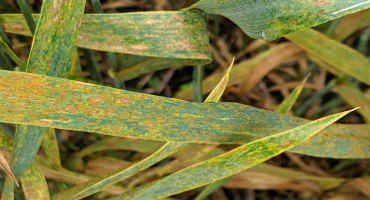By Emmanuel Byamukama, Shaukat Ali, and Connie Strunk
Winter wheat is past the need for an in-season fungicide application to manage fungal diseases, however, many spring wheat fields are yet to flower, making them prone to disease development. A few diseases, including leaf rust, stripe rust, and Fusarium head blight, have developed in winter wheat. This implies that there is enough inoculum available for these diseases to develop in spring wheat; especially East River, where rainfall has been frequent.
Diseases to Watch For
LEAF RUST
Leaf rust develops under warm temperatures (65-77° F) and humid conditions. This disease has reached yield reducing levels in some winter wheat fields (Figure 1). It has potential to develop in spring wheat, especially in fields that are at or have not reached the flag leaf growth stage. Stripe rust may not be a huge concern in spring wheat because this rust develops under cooler temperatures (<65° F). However cooler nights might cause stripe rust to develop at low severity levels.

Figure 1. Severe leaf rust developing in winter wheat near Brookings. Picture taken July 2, 2019